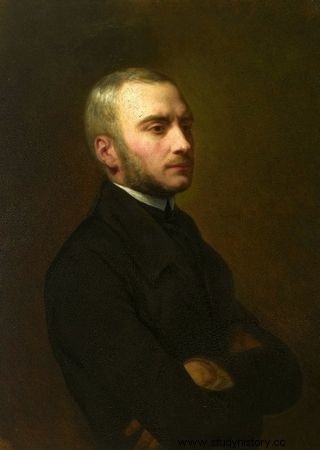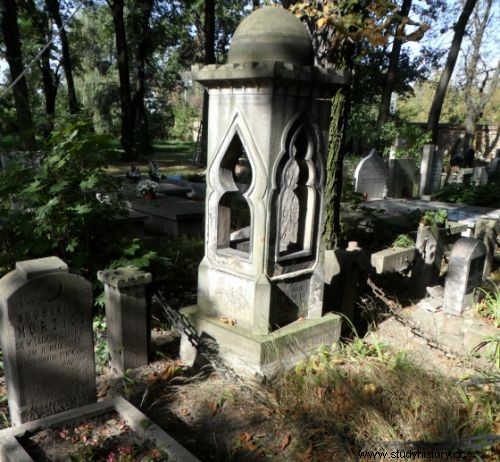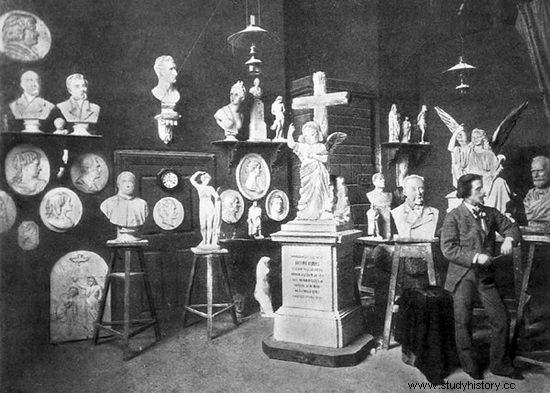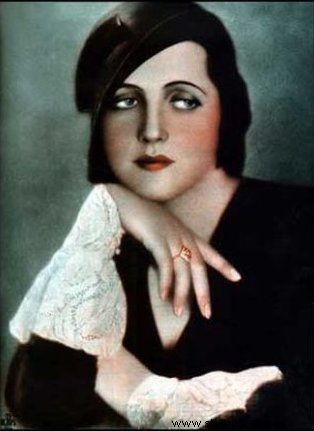Stories of broken hearts are often tragic and intriguing at the same time. They attract the attention of their fate, but also magic, which means that the fate of suicides is never indifferent to them. They force you to stop even for a moment and think about the reasons for such dramatic steps. One of such shocking stories is hidden in a grave on the mizarze at ul. Tatarska 8 in Warsaw.
At the Muslim Tatar Cemetery at ul. Tatarska - among more than a hundred-year-old graves where Lithuanian-Polish Tatars and other Muslims are buried - one stone tomb caught my attention. It looks like a minaret. Beautifully decorated, with engraved stanzas of a poem by Zygmunt Krasiński entitled "Resurrecturis": Multiply you one by the deeds of the living, / And you will be one - thousands! It is no wonder that the monument makes such a great impression.

On the tombstone of Abdul Halik Usmi, words from a poem by Zygmunt Krasiński entitled "Resurrecturis".
It is the work of an outstanding Warsaw artist and stonemason, Bolesław Sypniewski. The following is inscribed on the disc: Abdul Halik Usmi / Żył lat 29 / Revised on March 13, 1932 . Death at such a young age foreshadows some tragedy, a sudden event that interrupted his young life.
Many questions arose in my head about this mysterious monument. What mysterious story was he hiding? Who was that Abdul? What caused his death?
When I started looking for information about him, it turned out that Abdul Halik Usmi aka Halik Ahmed Usmi Bey (proper name Halik Abdul-Usmi-Bey) was a Turk, a native of Istanbul. Apparently he came from a noble family, and in Poland he used the ducal title.
Science brought him to the Vistula River. In Warsaw, he started studies at the Higher School of Economics. However, while browsing the pre-war press, I discovered that the hero of this story was also a stuntman. As a voltaire, he doubled several acting roles in difficult scenes in Polish films. He became very close to the Warsaw acting community. He was a frequent visitor to "Oaza", a very famous restaurant, located at Wierzbowa 9. Also in "Oaza" there was a cabaret founded by Julian Krzewiński and Władysław Walter, a dancing and a bar-grill room . Alcohol, women, dancing and singing - such a combination guaranteed numerous fights and duels among tipsy guests.

Mysterious monument at the Muslim Tatar Cemetery (photo:Krzysztof Bassara).
Not the first and not the last bloody drama in "Oaza" took place on New Year's Eve in 1931. Its infamous hero was Abdul Halik Usmi. This story shocked public opinion all over Poland. The events that took place at Wierzbowa 9 were widely commented in the pages of numerous dailies. As reported in Krakow's "Czas" on January 2, 1931:
On January 1, 1931 at 5:45 am in the "Oaza" restaurant, Major Sobolewski from the DOK I staff was sitting at one table, accompanied by two men and three ladies . Two gentlemen took their places at the next table, namely Usmi-Halik, a student of the trade college, and Hamid-Czołak-Zakek, a merchant. At one point Mr. Usmi began to observe Maj. Sobolewski and smile ironically at him.
In order to avoid a row, Major Sobolewski settled the bill and together with the whole company left the restaurant, going to the cloakroom. […] Because while he was getting dressed, Usmi started to provoke again, Major Sobolewski asked him what he wanted? In response, Mr. Usmi actively insulted Major Sobolewski, who covered himself with his hand. When Mr. Usmi repeated the blow to the hand of Maj. Sobolewski took out his revolver and fired twice at Usmi. After these shots, Usmi attacked Maj. Sobolewski, who fired another three shots, as a result of which Mr. Usmi was wounded in the neck.
During this shooting, one of the people staying at the club was accidentally shot. The case ended in court.

Bolesław Syrewicz in the studio at the Royal Castle
The article would suggest that our hero committed a completely unprovoked attack on the honor of the Polish officer. The further course of history suggests that this was not the case. The cause of his real tragedy was love. Usmi fell in love with the famous Polish actress Jadwiga Smosarska, considered the biggest star of Polish pre-war cinema and theater. The Turk sought the heart of a beautiful artist, but she rejected her lover.
Sensitive and restless, but at the same time demanding strong experiences, the eastern soul could not stand it this time. As Emil Cioran once wrote in "The Bad Demiurge": There are nights when the future loses all importance, and of all its moments there is only the one in which we decide to end ourselves . Lonely and misunderstood, engrossed in some inhuman pain, Usmi decided to kill himself. On Sunday, early in the morning, on March 13, 1932, at the Dormitory at ul. Akademicka 5, he killed himself with a revolver.

Jadwiga Smosarska. Femme Fatale of the unfortunate Abdul.
However, it was not this version of events that survived in the beautiful legend repeated for decades in Warsaw. According to it, Usmi died tragically in a duel in 1932, at the age of 29, defending the honor of the famous actress Jadwiga Smosarska, whom he admired (quote from:J. Kałuszka, Tatarski i caucasian , "Kultura pogrzebu", 2007, no. 3). What's more, the rumor is that it was the actress herself who had funded this tombstone for him. Even before the outbreak of World War II, someone looked after the lonely grave of Abdul Halik Usmi. Apparently, Smosarska herself also visited it, when she returned from emigration to the USA many years after the war.
